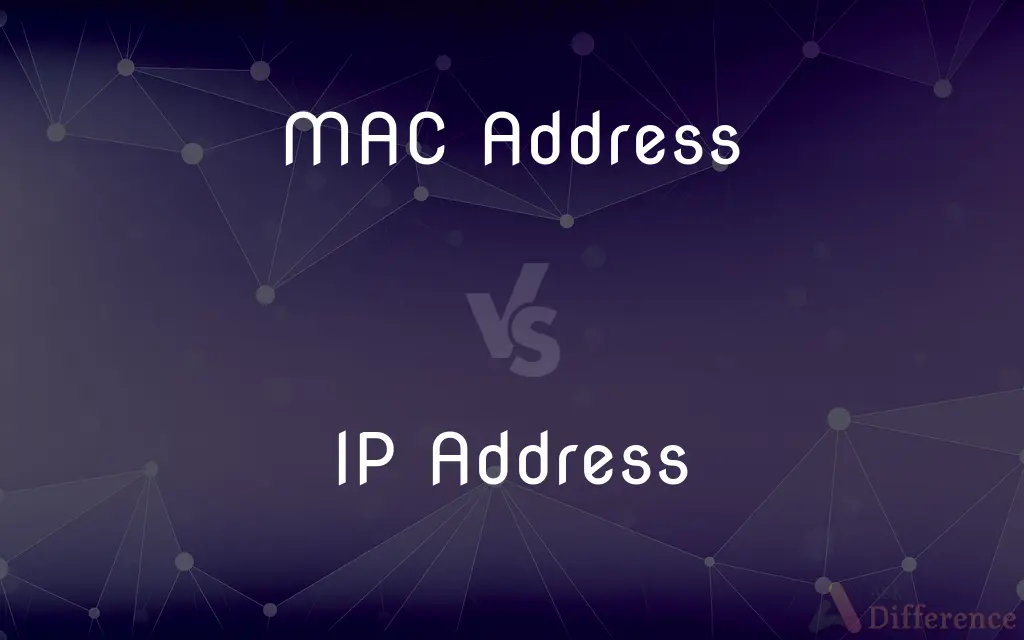MAC Address vs. IP Address — What's the Difference?
By Tayyaba Rehman — Published on January 15, 2024
A MAC address is a unique hardware identifier for network devices, while an IP address is a numerical label assigned to each device on a network for communication.

Difference Between MAC Address and IP Address
Table of Contents
ADVERTISEMENT
Key Differences
A MAC Address, or Media Access Control Address, is a hardware identification number that uniquely identifies each device on a network. It is assigned by the manufacturer and embedded into the network interface card (NIC). Conversely, an IP Address, or Internet Protocol Address, is a logical numeric address assigned to each device participating in a computer network that uses the Internet Protocol for communication.
The MAC Address operates at the data link layer (Layer 2) of the OSI model, ensuring the physical address of the computers on a local network. The IP Address functions at the network layer (Layer 3), facilitating logical addressing and routing on a larger scale network like the internet. The MAC Address remains fixed to the device's hardware. On the other hand, the IP Address can change depending on the network a device joins.
When a device attempts to connect to another on a local network, it uses the MAC Address to ensure the physical address of the destination device. IP Addresses are used to locate devices across different networks and direct data where it needs to go via routers. A MAC Address is a 12-digit hexadecimal number; for example, "00:1A:2B:3C:4D:5E". An IP Address is typically a 32-bit number for IPv4, like "192.168.1.1", or a 128-bit number for IPv6.
In practice, while a MAC Address is important for local communications, it is the IP Address that is vital for internet activities. Devices on the same local network can communicate directly using MAC Addresses, but to communicate over the internet, data packets must be transmitted using IP Addresses.
Comparison Chart
Scope
Hardware specific, permanent
Network-specific, can be dynamic or static
ADVERTISEMENT
Assigned by
Manufacturer
Network Administrator or automatically by DHCP
Used for
Local network identification, Layer 2
Global network identification, Layer 3
Format
12-digit hexadecimal
32-bit number (IPv4) or 128-bit (IPv6)
Example
00:1A:2B:3C:4D:5E
IPv4: 192.168.1.1 / IPv6: 2001:0db8::1
Compare with Definitions
MAC Address
Not routable across the internet unlike IP addresses.
MAC Addresses such as 08:00:27:ea:b1:2d are used for local network traffic control.
IP Address
A numerical label assigned to devices in a network for identification and location addressing.
Type the IP Address 192.168.0.1 into your browser to access the router settings.
MAC Address
Remains constant and can be used for device identification in a local network.
I used the printer's MAC Address to identify it on our LAN.
IP Address
Can be dynamic, changing with each connection, or static, permanently assigned to a device.
My server has a static IP Address to ensure reliable access.
MAC Address
A unique identifier assigned to network interfaces for communications at the data link layer.
The network card's MAC Address 00:1A:2B:3C:4D:5E was registered in the device's settings.
IP Address
Subject to subnetting, which divides the IP Address into a network and host identifier.
With subnetting, part of the IP Address specifies the network, while the rest identifies the device.
MAC Address
A permanent address embedded into the hardware by the manufacturer.
When setting up the network, I listed the MAC Address of each device for security purposes.
IP Address
IPv4 addresses consist of four numbers separated by dots, while IPv6 uses eight groups of four hexadecimal digits.
The new devices use an IPv6 address, like 2001:0db8:85a3:0000:0000:8a2e:0370:7334, to connect to the network.
MAC Address
Consists of six pairs of hexadecimal numbers, usually separated by colons.
Your MAC Address, AB:CD:EF:12:34:56, is required to connect to this network.
IP Address
Facilitates device communication over the internet, not tied to hardware.
After resetting the modem, my computer was assigned a new IP Address.
Common Curiosities
Is a MAC Address or IP Address more important for networking?
Both are crucial; MAC for local hardware identification, IP for logical network addressing.
What is DHCP in the context of IP Addresses?
Dynamic Host Configuration Protocol automatically assigns IP Addresses to devices in a network.
Are MAC Addresses unique worldwide?
They are meant to be globally unique, although duplicates can occur due to errors or spoofing.
How does a computer get its IP Address?
Usually through DHCP from a router or manually set by an administrator.
Can two devices have the same MAC Address?
They shouldn’t, but MAC Address duplication can happen, typically due to manufacturing errors.
What's an APIPA IP Address?
Automatic Private IP Addressing assigns a default IP when DHCP fails.
Why might an IP Address be blacklisted?
Due to suspicious activities like spamming or malicious attacks.
How do devices use IP Addresses?
For identifying and communicating with other devices over a network, particularly the internet.
Are IP Addresses linked to specific countries?
Yes, certain ranges are allocated to different countries.
Can a MAC Address be changed?
It's hard-coded to the device but can be spoofed by software.
Do IP Addresses reveal my location?
They can reveal approximate location like city or region but not precise physical location.
Is a MAC Address or IP Address better for security?
IP Addresses are more commonly used for security measures such as firewalls.
What happens if my IP Address changes?
It may affect remote access and location services but not local hardware identification.
Can I find my device’s MAC Address remotely?
Generally, no, because MAC Addresses are mostly used for local network traffic.
Can MAC Addresses be used for device tracking?
Yes, in local networks, they can track devices or control access.
Share Your Discovery

Previous Comparison
SoapUI vs. Postman
Next Comparison
Array vs. Linked ListAuthor Spotlight
Written by
Tayyaba RehmanTayyaba Rehman is a distinguished writer, currently serving as a primary contributor to askdifference.com. As a researcher in semantics and etymology, Tayyaba's passion for the complexity of languages and their distinctions has found a perfect home on the platform. Tayyaba delves into the intricacies of language, distinguishing between commonly confused words and phrases, thereby providing clarity for readers worldwide.












































